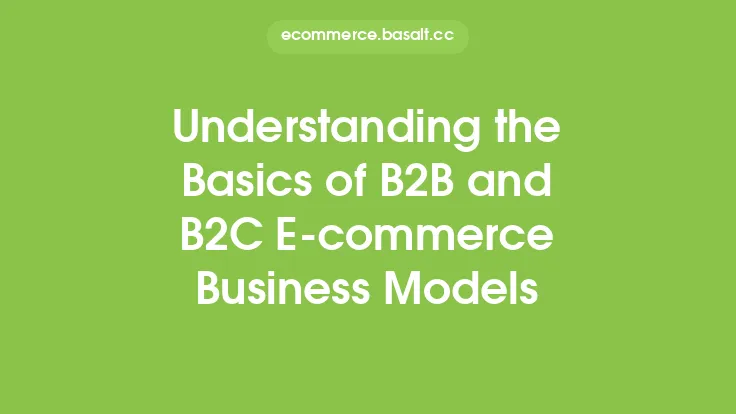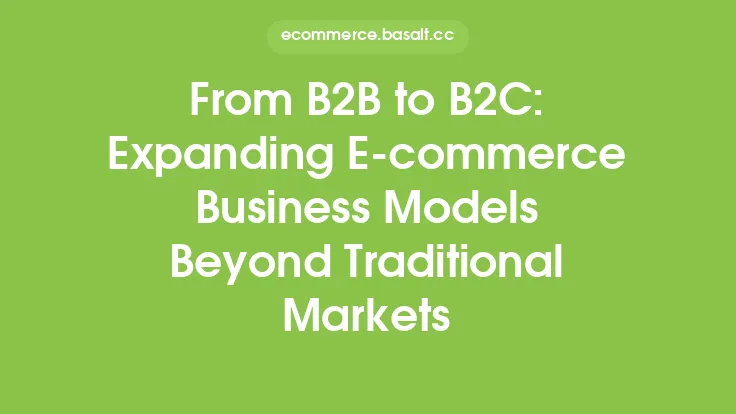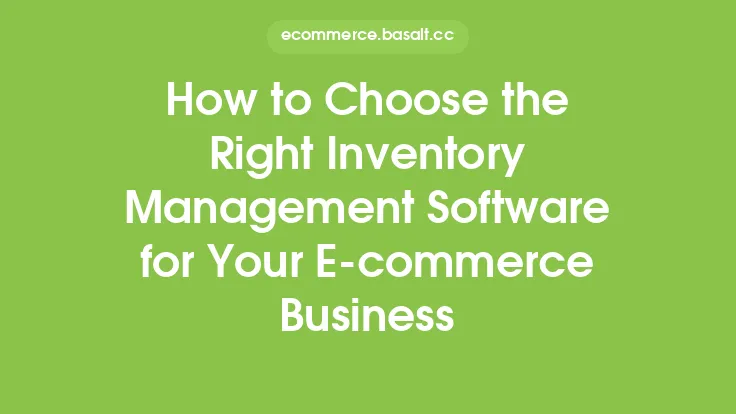When it comes to e-commerce, businesses have two primary models to choose from: B2B (Business-to-Business) and B2C (Business-to-Consumer). While both models have their own set of advantages and disadvantages, the key to success lies in choosing the right model that aligns with your business goals, target audience, and product offerings. In this article, we will delve into the world of B2B and B2C e-commerce, exploring the differences between the two models, their characteristics, and the factors to consider when deciding which model is best for your business.
Understanding B2B E-commerce
B2B e-commerce refers to the online transactions between businesses, where one business sells its products or services to another business. This model is often used by manufacturers, wholesalers, and distributors who sell their products to retailers, other businesses, or organizations. B2B e-commerce typically involves larger order quantities, higher prices, and more complex sales processes compared to B2C e-commerce. The B2B model requires a deeper understanding of the business customer's needs, preferences, and purchasing behaviors, as well as the ability to provide customized solutions, flexible pricing, and reliable logistics.
Understanding B2C E-commerce
B2C e-commerce, on the other hand, involves online transactions between a business and individual consumers. This model is used by retailers, brands, and manufacturers who sell their products directly to end-users. B2C e-commerce is characterized by smaller order quantities, lower prices, and simpler sales processes compared to B2B e-commerce. The B2C model requires a strong focus on customer experience, user-friendly website design, competitive pricing, and fast shipping options. B2C businesses must also be able to effectively market their products to individual consumers, often using social media, advertising, and other digital marketing channels.
Key Differences between B2B and B2C E-commerce
While both B2B and B2C e-commerce models share some similarities, there are several key differences that set them apart. Some of the main differences include:
- Target audience: B2B e-commerce targets businesses, while B2C e-commerce targets individual consumers.
- Order quantity and value: B2B orders are typically larger and more valuable than B2C orders.
- Sales process: B2B sales processes are often more complex and involve multiple stakeholders, while B2C sales processes are simpler and more straightforward.
- Pricing and payment: B2B pricing is often more flexible and negotiable, while B2C pricing is typically fixed and non-negotiable.
- Marketing and sales strategies: B2B marketing and sales strategies focus on building relationships and providing customized solutions, while B2C marketing and sales strategies focus on promoting products and driving traffic to the website.
Factors to Consider when Choosing between B2B and B2C E-commerce
When deciding which e-commerce model to choose, businesses must consider several factors, including:
- Product offerings: Are your products more suitable for businesses or individual consumers?
- Target audience: Who are your ideal customers, and what are their needs and preferences?
- Competitive landscape: What are your competitors doing, and how can you differentiate your business?
- Resources and capabilities: Do you have the resources and capabilities to support a B2B or B2C e-commerce model?
- Growth potential: Which model offers the most growth potential and opportunities for expansion?
Benefits and Challenges of B2B and B2C E-commerce
Both B2B and B2C e-commerce models have their own set of benefits and challenges. Some of the benefits of B2B e-commerce include:
- Higher order values: B2B orders are often larger and more valuable than B2C orders.
- Long-term relationships: B2B e-commerce allows businesses to build long-term relationships with their customers.
- Customized solutions: B2B e-commerce enables businesses to provide customized solutions to their customers.
Some of the challenges of B2B e-commerce include:
- Complex sales processes: B2B sales processes can be complex and involve multiple stakeholders.
- Higher operational costs: B2B e-commerce often requires higher operational costs, including logistics and customer support.
Some of the benefits of B2C e-commerce include:
- Lower operational costs: B2C e-commerce often requires lower operational costs, including logistics and customer support.
- Faster time-to-market: B2C e-commerce enables businesses to quickly launch new products and reach a wide audience.
- Competitive pricing: B2C e-commerce allows businesses to offer competitive pricing and promotions.
Some of the challenges of B2C e-commerce include:
- Intense competition: B2C e-commerce is highly competitive, with many businesses competing for the same customers.
- High customer expectations: B2C customers have high expectations for fast shipping, easy returns, and excellent customer service.
Conclusion
In conclusion, choosing the right e-commerce model is crucial for businesses looking to succeed in the online marketplace. By understanding the differences between B2B and B2C e-commerce, businesses can make informed decisions about which model is best for their products, target audience, and growth goals. Whether you choose to focus on B2B or B2C e-commerce, it's essential to prioritize customer experience, build strong relationships, and stay competitive in a rapidly evolving market. By doing so, businesses can unlock new opportunities, drive growth, and achieve long-term success in the world of e-commerce.





